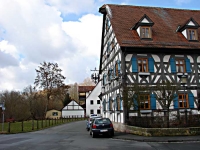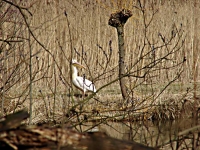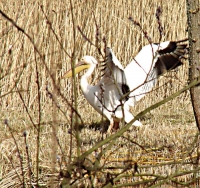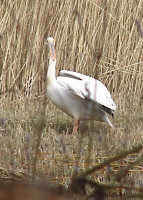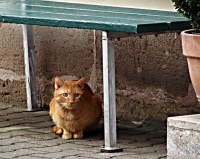Monthly Archives: March 2009
Nüggets
Bavarian remnants on the Channel Isles/
The Alpine Schunklers Oompah Band, with its accordionist Ken Gordon, presents ‘Music and song from the Bavarian beer festivals’ (note that what the British think of as ‘Roll out the Barrel’ is ‘Rosamunde’ in German).
Our repertoire consists of music and song from the bier festivals, marches, waltzes and polkas. We integrate many audience participation spots such as the Ladies Horn Blowing Competition followed by the men’s Yodelling session. Lili Marlene followed by the music man and Al Jolson pops up frequently for an up tempo sing-along accompanied by a Singalongamax ditty.
Schunkling and Ein Prosit’s throughout marching back to the bier kellar scene for more authentic polkas and some beautiful Strauss waltzing and cuckoo waltz, Alte Kameraden, Radetski march, Drinking song, In Munchen Stheit, Trink Trink Pruderline Trink, etc etc.
(sic)
For even more exciting accordion playing see Charles Magnante and his Trio (at least partially deceased) and – coming soon – the Baldie.
Times Spelling Bee/Englische Orthographie-Test
When I read at Swordplay about the Times Spelling Bee, I thought they meant the New York Times – but no, it’s the so-called London Times Spelling Bee site.
Mind you, if you write ‘higher’ instead of ‘hire’ you’ll get thrown out, and similarly if the speaker mumbles so you write ‘boo’ instead of ‘booth’.
There are various levels, some very easy.
Another blog about Germans/Ich werde ein Berliner
Ich werde ein Berliner seems to take Nothing for Ungood a step further.
The year is 2009. Berlin is hip. Germany is hip. Are you struggling to make some German friends? This blog will teach you how to blend in “wiz ze” Germans.
When you ask a German person why he likes to go to Aldidl, he or she will give you a surprised look and say “because they have the exact same product as other supermarkets, only in another packaging!”. As German people are always eager to 1-up others on bargains, they will happily buy whatever is on sale that week, needed or not. Then they will drive back to their house via the Autobahn at 120 mph, burning 3 times the amount they saved on gasoline. Back home, they will compose a bunch of text messages on their “Handy’s” at 25 cents a piece, bragging to their friends about the great bargains they found again at Aldidl.
(Via …jurabilis!
Bundesarchiv in Wikimedia Commons
From Wikimedia Commons:
Starting on Thursday Dec 4, 2008, Wikimedia Commons witnessed a massive upload of new images. We received nearly 100,000 files from a donation from the German Federal Archives. These images are mostly related to the history of Germany (including the German Democratic Republic) and are part of a cooperation between Wikimedia Germany and the Federal Archives.
Vom Bundesarchiv:
Wikimedia Commons wird vom Bundesarchiv um 100 000 historische, zum Teil einmalige Fotos bereichert. Wikipedia wiederum unterstützt das Bundesarchiv bei der Zuordnung von Nummern der sogenannten Personennamendatei (PND) zu den Einträgen in der Personenliste des Bundesarchivs und bei der Erschließung von noch nicht identifizierten Bildern. Dadurch ziehen Bundesarchiv und Wikipedia gleichermaßen Nutzen aus dieser beispielhaften Beziehung.
Here’s an example: the ‘zeppelin on rails’ (Schienen-Zeppelin) arriving in Berlin on 21 June 1931.
(Thanks to Trevor)
Jonathan Littell, W.G. Sebald
My attention was drawn to the reviews of Littell’s The Kindly Ones in the USA. Take this one from the Los Angeles Times, for instance (thanks, Isabella!), and better-known very harsh reviews in the New York Times and the Literary Saloon (for a different view, see here). The reception was much more positive in France, I read – and it certainly was in Germany. I haven’t read the book but the temptation is growing. I don’t like the sound of the past life Littell has given his main character, but I can’t help feeling the reactions have something to do with distance from Europe. Then again, the book was written in French by an American who grew up in France, so I can’t judge it as if it were a German book. Part of the German reaction was that it needed a non-German to actually put the holocaust into a novel.
I just recently finished W.G.Sebald’s Austerlitz, another book about the holocaust. Sebald seems to have emigrated from Germany to some extent because of the silence about the recent past in 1950s and 1960s Bavaria (people kept quiet about the past in Britain too in those times, but what they kept quiet about did not have the same dimensions). He seems to have believed that the holocaust could not be written about directly, only indirectly. Maybe that’s why it takes such a very long time for Austerlitz to put its cards on the table.
Searching for people writing about Sebald in English on the Web, it’s striking how much adulation there is in English-speaking countries. It’s odd how Sebald is taken on as if he were an English-language writer (fortunately the translators, Michael Hulse and Anthea Bell, do get some praise). One person even expressed surprise that Sebald, whose English was so good, decided to write in German. But they are very German books, to my mind. In Text und Kritik no. 158, on Sebald, Rüdiger Görner considers this aspect:
Seltsam genug, aber vielleicht nicht unbedingt verwunderlich: Sebalds durchaus kritisches England-Bild und das beinahe auf Kritik verzichtende Bild, das sich (vor allem) englische Kritiker von ihm gemacht haben, sind nur bedingt deckungsgleich.
The first thing of Sebald’s I read was Die Ausgewanderten (The Emigrants), when it first came out in the Andere Bibliothek in 1992. That was his second novel, but the one that led to the breakthrough, especially when it first appeared in English in 1996. It’s not actually about four Jewish emigrants, as is often said – one of the stories is about relations of Sebald’s, Germans who went to the USA. In the last story, of Max Ferber (still called Max Aurach in my edition), the diaries of the artist’s mother conjure up a world where Jewish life and German life could mean the same thing – this is another indirect evocation of the horror of the holocaust. (And this book might be the best place to start reading Sebald).
Last year I read Die Ringe des Saturn (The Rings of Saturn), enjoyed it at the same speed as I had Die Ausgewanderten. I reread Die Ausgewanderten this year to see how it stood up to the test of time.
(The only other Sebald I have read is part of Logis in einem Landhaus – essays on Robert Walser, Hebel, Keller, Rousseau, Mörike and Tripp).
Two things that struck me about Die Ausgewanderten: in connection with the theme ‘The dead are always returning to us’, there is a clear reference to Hebel’s Unverhofftes Wiedersehen, a story unlikely to be known to an English reader. That almost needs a footnote, but I suppose it is not essential. (I see that a translation appeared in Penguin Books in 1994, translated by John Hibberd: The Treasure Chest: Unexpected Reunion and Other Stories). Another thing is the topos of the butterfly collector, a reference to Nabokov and presumably to his autobiography Speak, Memory. That would be far too obvious in an English novel, but in German it may work.
Wikipedia has a list of all the influences on Sebald. Adalbert Stifter strikes me as the strongest. And I think a good description of both Stifter and Sebald is ‘Boring, but in a good way’. I can’t remember where I came across the word ‘boring’ in connection with Sebald, but it struck me as a good one immediately. Boring and yet hypnotically fascinating at the same time. I can see the Bernhard influence now, at least in the language as well as in the sentence length, but their subjects don’t seem closely related.
Five Dials is an online literary magazine (PDF file) from the publisher Hamish Hamilton. The fifth edition features W.G. Sebald.
dovegreyreader on The Emigrants
Via Vertigo
Interview with Sebald, interviewer Michael Silverblatt, dated 2001.
The Kissinger Saga/Die Kissinger Saga
Evi Kurz’s book – following her TV programme – on Walter and Henry Kissinger has now been translated into English, although no translator is named. It got a glowing review in the Sunday Times. I suppose it’s true that she had a rare success in getting Kissinger to talk about his childhood, and had she been more critical, it wouldn’t have worked.
This is a magnificent story about boyhood, identity and belonging. When Kurz began making the programme six years ago, Henry kept ducking out of his on-camera interview on the grounds that he was too busy, even though he is now more than 80, and, frankly, not that indispensable to the Chinese and other governments that pay him so well. Kurz painstakingly gathers the material of the brothers’ earlier lives with Walter’s help, and finally appears for her interview with Henry, who claims he can spare her only 20 minutes in his Stygian New York office.
As the cameras are readied, however, Kurz disarms him by presenting him with leaves she has brought with her from Germany from a damson tree in his grandparents’ garden. Kissinger, the self-important Manhattan hired gun who will provide corporate advice for anyone for a negotiated fee, is briefly caught emotionally off-guard and his voice falters as he thinks of his family who perished.
The publisher’s blurb says:
‘No interviews about my private life’ has always been Henry Kissinger’s response to curious journalists. But journalist Evi Kurz from Furth, from the Kissingers’ home town in southern Germany, proposed a family portrait and eventually managed to win the trust of both brothers. This is the story of two Americans of German-Jewish descent: one of them a key figure in Cold War diplomacy and winner of the Nobel Peace Prize, the other a top businessman – two lives which are exemplars of the American dream. When Louis and Paula Kissinger’s sons were born – Henry in 1923 and Walter in 1924 – the Kissingers were part of a flourishing Jewish middle class in Furth, a large market town in northern Bavaria. But then Hitler came to power. Evi Kurz describes the gradual but remorseless destruction of Furth’s Jewish community in the 1930s; the Kissinger family’s emotional farewell to Germany in 1938 and their escape to New York; the family’s war years in America; and the hugely successful careers in postwar America of both brothers, who nevertheless remembered and cherished their German home and roots.
I was reading Christopher Hitchens, The Trial of Henry Kissinger, but it was fairly heavy going and I seem to have stopped after Child.
Bundesverband deutscher Apothekerverbände
I see that even the Bundesverband deutscher Apothekerverbände uses English in its viral video advertising (the punchline is in German). (Via Die Zeit)
Pelican/Pelikan
I have at last succeeded in photographing Quaks. I phoned the Bavarian Bird Association pelican ‘hotline’ and they suggested I parked in the centre of Frauenaurach and walked down the Brauhofgasse, since the pelican has been spending the night on the Schwarzer Adler:
I saw two pairs of storks on chimneys. They were quite noisy:
I didn’t think I was going to see the pelican, but he was standing there next to a pond, beside a small pollarded (and dead) willow, unfortunately behind barbed wire and small branches:
Google Maps shows Frauenaurach. The pond can be seen near Brauhofgasse and the River Aurach.
After that he flew away. Later, I saw him flying over the bridge over the Regnitz.
Brewery cat:
Now my pelican pictures have joined the rest on the website of the Landesverband für Vogelschutz in Bayern.




